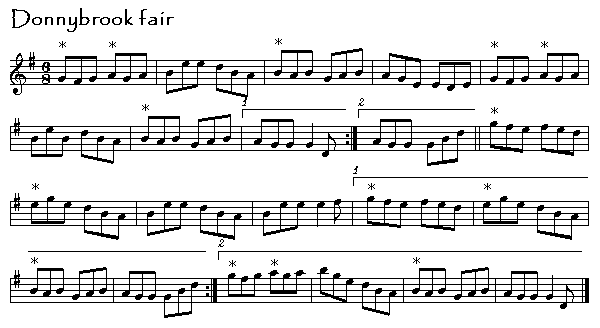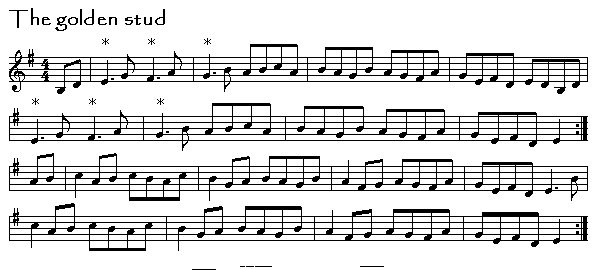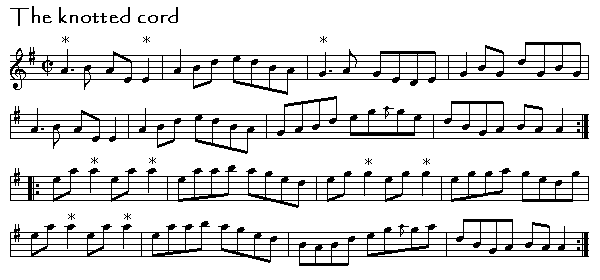Rolls - a practice page
On the use and overuse of rolls
Now that you've seen how easy it is to execute rolls -- once you've understood the magic of dah-blah-blah, all you have to do is practise -- you'll be keen to be seen and heard playing them all over the place. And I have a few tunes for you to work on them in greater depth further down on this page.
But before we go there... A few words of caution. Please remember:
1. Knowing how to play rolls won't necessarily make you an advanced, or even a middling, player of Irish music. No matter how well you play rolls, your playing will never sound authentic unless your underlying rhythm is good for the type of tune you are playing.
For example, if you can't play a reel decently without using rolls, trying to add rolls is only going to make things worse. Believe me. So please balance the time you spend on these critters with attention to basic rhythm, steady tempo, etc.
2. Less is often more. A well-played roll is a satisfying thing, indeed. But as you master them, I would suggest you curb the temptation to put them in absolutely everywhere you can.
For one thing, you can easily obscure or erode a satisfying melody by cluttering it up with non-stop rolls. For another, if you play nothing but rolls, you're merely demonstrating the fact that you can't think of anything more varied or creative to do with the tune!
OK, enough pontificating already. Let's look at a couple of tunes to practise rolls in.
Practising your long rolls: Donnybrook fair
Here's a good jig for spicing up with a few long rolls. In the music below, the asterisks (*) indicate places where you could very well use a long roll. I've used this notation rather than the ~ symbol because I want to stress the point that rolls indicated on the sheet are always optional.
In the sound clip of the entire tune below, I don't play all the possible rolls I have indicated, and those that I do play I don't do every time.

For the sake of this example, I'm going to play long rolls on three notes only: G (in both octaves), B and E (in the second octave).
|
|
Click the icon for a clip of these rolls played slowly (47K) |
|
|
Now here is the whole tune, played at a reasonable speed (153K) |
For more hints on playing jigs such as this one,
see the topic
Jigs: trickier than you think
.
More long rolls: The golden stud
Here's a dinky little reel that gives you a chance to practise perfecting your long rolls on E, F# and G. It's called The golden stud I'll assume it refers to the stud on an old-fashioned collar!) and I believe it was composed by Paul Roche, flute player with the band Stockton's Wing.

Just to remind you of the basic dah-blah-blah rhythm of long rolls:
|
|
Click the icon to listen to long rolls on E, F# and G played alone, and then as they occur in the the first two bars of the tune (35K) |
|
|
Now here is the entire tune, played a little quicker (200K) |
Have fun with this reel. It's made up of short, very repetitive phrases, so you'll need to try varying things a little. Otherwise by the time you get once through the tune your listeners will be starting to get bored and wonder if you have any tricks up your sleeve, or if you merely learned the tune off the music posted on some web page!
Mainly off-beat rolls: The knotted cord
Many people find rolls on A hardest to perform, mainly because you have to tap with the ring finger of your weaker hand. This fine old reel, The knotted cord gives you a chance to practise both long and off-beat rolls (see the previous page on rolls for a definition) on A, and on G.

|
|
Here's a clip of a couple of long A rolls, followed by the first 2½ bars of the first part played slowly (46K) |
For the off-beat roll at the end of the first bar , I tongue before the second eighth-note, i.e. the E eighth-note, and then slur into the rolled E quarter note. This is my usual pattern for tonguing off-beat rolls, although sometimes I don't tongue at all.
|
|
Now here are bars one and 3 of the second part, again played slowly (19K) |
Again, I use the same tonguing pattern for these off-beat rolls: I tongue the eighth note immediately before the quarter note on which the roll falls.
|
|
Once you have these rolls going satisfactorily, you can tackle the entire tune (175K) |
Next page: Short rolls
Previous page: Off-beat rolls
Site contents: Back to the home page
Updated 14 October 2004

